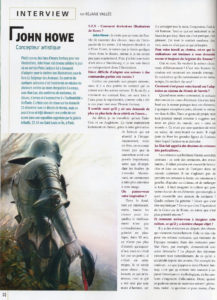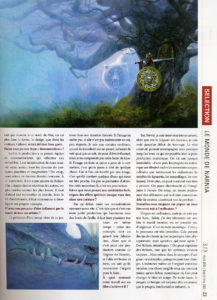John Howe Talks Narnia
Concept artist John Howe speaks to French magazine SFX about his work on The Lion, the Witch, and the Wardrobe. Thanks to Alexandre Tuis we have a scan of the interview, plus the translated transcript by myself.
SFX: Best known by fans of epic fantasy for his illustrations, John Howe became famous the day a certain Peter Jackson asked him to adapt his Lord of the Rings book illustrations for film. This several-week contract turned into a mission that lasted several years, over the course of which he conceived, with Alan Lee, hundreds of costumes, settings, armour, and accessories of a created authenticity. The artist returns to the screen on the 21st of December [French release date] with The Chronicles of Narnia, but you can now already discover part of his work in an exhibition organised by the Galerie Artludik, 12-14 rue Saint Louis en Ile, in Paris.
SFX: How do you become a book illustrator?
JH: I believe it comes from wanting to say things, but being unable to write them. I’ve always drawn things, and when I was 15 or 16, I knew that I would do something to do with art, even if I didn’t know exactly what. Then I went to an art deco school in Strasbourg, and threw myself into being a freelance illustrator.
SFX: Is it difficult to adapt your creative universe to more varied requirements?
JH: Certainly, you have your own universe, but there are points of contact which align themselves with other universes. And there where there is truly strong contact, you’re very comfortable in representing it, as has been the case for me with epic fantasy.
SFX: It also seems that there has been a stronger and stronger demand for this sort of thing in France …
JH: At the beginning, I only worked in the United States and England. It’s now coming slowly in France, thanks to this generation of readers who pay attention to the art. Beforehand in a book, people didn’t think that the cover played an important part other than to prevent the pages from falling out. Now they’re beginning to pay more attention to the picture.
SFX: Where do you get your inspiration from?
JH: Deep down, everything is interesting, at least, all the things where aging isn’t contradictory. In 50 years, a plastic cup won’t be any more interesting than it is today, but if it were made by a potter, if it were ceramic, that would be another matter. What interests me is hand-created stuff, as in spite of everything, there’s the imprint and eye of a real person involved. All the industrial stuff doesn’t connect with me very much. Of course, it is still practical and pleasant. I have all the modern comforts at home, but those don’t inspire me.
SFX: For your film work, do the filmmakers tend to ask you to produce Lord of the Rings all over again?
JH: Yes and no. They want the same thing, but different! It’s very bizarre. Cinema is truly a strange world … they want things that they already know, and at the same time, they want new things!
SFX: How did your work go on the film adaptation of the Chronicles of Narnia?
JH: When we began, the script was still being written. So we based things on the book, since nearly all its elements, with a few exceptions, were going to be in the film. With this type of project, my first task is suggesting an environment for the world, a created world. It isn’t just a question of setting the scene, of storyboards or anything. It’s about setting up the big structures of the universe in which the action is going to unfold.
SFX: The film requires lots of special creatures …
JH: The creatures that live in Narnia are already well known, they’re the centaurs, minotaurs … you have to take this miscellaneous ensemble and integrate them into a coherent world. It isn’t about placing a centaur on the right, a minotaur on the left, adding a castle, and mixing the lot … you have to imagine a culture that supports each of these elements: for example, what does a centaur’s armour look like? What was the culture that made it? Is it very sophisticated? Is it the equivalent of ancient Grecian or Roman culture, or is it more primitive?
SFX: And how did you imagine this culture, what’s the story behind each object?
JH: There’s some evidence that you can use as a point of departure, and some things that come naturally. That’s true for the centaurs, which come from the ancient Roman era. Designing centaurs for Star Wars, for example, would require a different approach! Most ideas come naturally from what you’ve accumulated over the years. For example, the colours; what I appreciate about epic fantasies is that they often take you back to a historical or mythological past, where the colours naturally impose themselves. So when you speak in terms of natural materials – stone, wood, metal – the question of colour is less important, so much so that often at this stage of the film, you’re more concerned with forms and designs, rather than the colours. Those are defined much later.
SFX: Did you go through the steps of doing research?
JH: Actually, the production has its own team of researchers who carry out the work. Their mission was to find us, among other things, all the possible and imaginable pictures of centaurs that there were! Suddenly we had an enormous centaur file. At that stage, there isn’t any order; each drawing is worth as much as the others, and the worst are alongside the best. First we had to gather them all and then sort them. At the same time, we begin to develop our own concepts.
SFX: Aren’t you afraid of being influenced by the work of all these artists?
JH: The power of an image comes from its relevance within a given situation. If the picture doesn’t add up, if it isn’t interesting in itself, it has little importance. I know that when some fellow artists work on a project, they refuse to look at what’s already been created because they’re afraid of being influenced, but I don’t understand that way of doing things. If the picture’s strong and you’re worried about copying aspects of it, you might pass over something good. Because if you’re touched by a picture, it means that it contains something that is very important to us. If you don’t allow yourself to absorb that influence, it’s a bit odd.
SFX: Do you think of the technical constraints of special effects when you design a creature?
JH: Not at the beginning, but these considerations arise pretty quickly. It’s clear that if it’s a smallish production, you have to do several types of work at the same time: create the concepts while managing to make them. Although if it’s a production like Lord of the Rings, if the idea is good and strong, you know that you can find the money to do it properly.
SFX: At what moment is your work on a film completed?
JH: On Narnia, I came into it very much in the stream of things, while on Lord of the Rings, I stayed until the beginning of the shooting. The dream would be to be able to accompany my concepts until the end, which has been made possible with digital post-production. We’ve heralded a great era: on one hand, the progress of digital work has eliminated all the little constraints that once plagued filmmakers (the number of characters, the makeup, the costumes). And furthermore, you can truly do everything at the moment. You can place things directly from your imagination onto the screen. Suddenly you now find references that often go well beyond cinema and carry over into painting!
SFX: Do you always work on paper or do you put things into the computer?
JH: A little bit on the computer, but I’m not very good. I’m a bit reluctant to do it, since once you’ve finished the work, you’re not left with anything original. It’s all digital. The process is certainly very quick. It allows you to do many things that you can’t physically do, but what’s left afterwards? Just some digital files? You can print the files, as long as the computer systems exist … but even then, the original work doesn’t exist, since you can change it all. The existence of an original gives you a bar to raise things to, something tangible, and that suits me better than a digital file where you can just change blue to red. Anyway, technological advancements are always moving along faster than intellectual or cultural progress …







